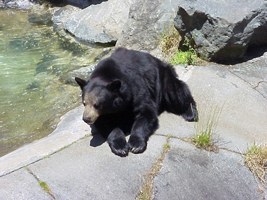Bear territory may be expanding
– but not to San Benito
It wasn’t so very long ago that humankind was not the big dog in
San Benito County. Until a little more than a century ago, even men
mounted on horseback kept a watchful eye for the only animal
capable of turning a day’s ride into a horror show nightmare.
Bear territory may be expanding – but not to San Benito
It wasn’t so very long ago that humankind was not the big dog in San Benito County. Until a little more than a century ago, even men mounted on horseback kept a watchful eye for the only animal capable of turning a day’s ride into a horror show nightmare.
Grizzly bears once padded through the mountains and valleys of San Benito County and the Central Coast. The last living example of Ursus arctos disappeared from California in the first years of the 20th Century, remaining only as an iconographic reminder of California’s wilderness past on the state flag.
When the first Spanish explorers began to traverse California, they encountered a place very different from the state we know today. Dead whales, castoffs from a population much larger than today’s, littered the beaches. Condors tore at their rich flesh and grizzly bears lumbered across the sands.
Historically, the lowlands belonged to grizzlies and the mountains were the home of a smaller, more docile member of the dog family, the black bear.
Smart, adaptable and fecund, black bears have not just remained part of the California landscape but thrived, growing in numbers and occupying sites far from their historic range. Today, biologists estimate California is home to twice as many black bears as it was in the 1980s.
And the Central Coast is among the animal’s adopted homes.
It was in 2001, a year in which weather conspired to deprive the region’s population of bears of their usual food, that the presence of bears in the area was noticed.
There had been scattered reports of bear sightings in the Santa Cruz Mountains for some years.
But the media had a field day when a bear turned up in a pine tree along Carmel’s main drag, Ocean Avenue.
The bear that wandered into the chic shopping Mecca seemed quite at home, until it was darted with a tranquilizer and euthanized. It was the same year that another bear turned up in an equipment rental yard in the middle of Salinas. Again the encounter did not end happily for the bear.
Suddenly, it seemed as if bears were everywhere on the Central Coast.
How long could it be before one wandered into public view in San Benito County?
Apparently, longer than many of us would have guessed.
An unscientific poll of resource managers, rangers, ranchers and wildlife specialists reveals no bear sightings between the Diablo and Gabilan ranges, and that should be no surprise, according to one biologist.
Existing bear populations are found in coastal ranges. Getting here from there involves crossing Highway 101, and several likely encounters with people.
“I don’t think they’ll come here from the Coast Range because they’ll have to cross areas that are heavily populated,” said Patty Forbes, a biologist on the staff at Hollister Hills State Park.
Forbes routinely encounters some of the area’s other most watchable wildlife. Feral pigs and wild turkeys, both non-natives introduced as game animals, are regulars. Forbes has even encountered a cougar, North America’s largest cat, and the only predator that poses any threat to humans.
That doesn’t worry Forbes. Given the population of pigs and turkeys, she sees no reason for cougars to tangle with “big, noisy animals” like humans.
Derek Davis, ranger at Fremont Peak State Park, also reports no word of bears in the mountain range his aerie crowns.
Ditto the staff at Pinnacles, and firefighters at CDF’s Bear Valley Fire Station.
The neat-as-a-pin station just off Highway 25 a few miles north of Pinnacles takes its name from the grizzlies that once roamed the area.
Given time, a new breed of bear may lend weight to that historic name again.
Forbes speculates that, if bears do come to San Benito County, it will not be via migrants from the Coast Range.
Just north of San Benito County is California’s second largest state park, an enormous swath of wilderness that’s lightly traveled by people. Henry Coe State Park encompasses more than 80,000 acres. If bears are anyplace in the Diablos, Coe is the best bet.
And Forbes’ speculation is congruent with the thinking of top wildlife biologists. Conservationists today are focusing on corridors rather than isolated tracts of wildlands. It’s a top goal for state parks acquisitions, Forbes noted.
Once areas of habitat are stitched together it’s possible for animals to recolonize new areas.
With Coe linking areas to the north to San Benito County, a natural conduit exists for the animal that may, someday, establish a new home in San Benito County.










